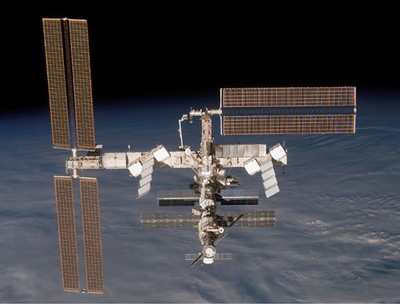Sat, Mar 17, 2007
Station Hits Lowest Average Altitude In History Of Project
Say... is that bright light in the sky getting closer? If you're
looking at the International Space Station... why yes, it is. But
NASA says there's no reason panic.

MSNBC reports NASA's tracking data shows the nine-year-old
station's orbital path has slipped to just 207 miles above the
Earth, its lowest average altitude ever. Rocket burns meant to send
the station into a higher orbit -- such as the series carried out
this week, using the engine of a docked Russian Progress module --
have resulted in only slight improvements.
The station has been falling since its first components were
placed in low-earth-orbit back in 1998, due to constant atmospheric
drag. But the decline took a noticeable dip in 2003, when NASA
grounded its space shuttle fleet following the loss of Columbia.
Visiting shuttles had been able to give sizable reboosts to the
station; since 2003, however, such firings have been done by the
much smaller Russian capsules.
NASA maintains the station's orbit is stable, and the Russian
firings are enough to keep the station from slipping ever closer to
Earth. Once larger components of the station are delivered and
installed by the space shuttle next year, the orbiters will resume
the primary responsibility for correcting the station's orbit.
"Our altitude is driven by shuttle rendezvous altitude limits,"
said Mission Control expert Ainsley Collins, who along with her
Russian counterpart helps coordinate reboost firings, and other
maneuvers.
"The lowest the station orbit has ever been was on May 23,
2000," Collins recalled, when the station reached its lowest point
after dropping 43 miles from a high orbit of 250 miles. A shuttle
then pushed the station higher... and over the next two years, the
station remained relatively stable at around 246 miles. Then the
slide began.
Collins added the boosts are barely noticeable to the station's
crew. The force produced by Thursday's 12.5-minute firing of the
Progress module's manuevering rockets only resulted in about .5 g's
of pull.
More News
From 2023 (YouTube Version): Legacy of a Titan Robert (Bob) Anderson Hoover was a fighter pilot, test pilot, flight instructor, and air show superstar. More so, Bob Hoover was an i>[...]
Get The Latest in Aviation News NOW on Instagram Are you on Instagram yet? It's been around for a few years, quietly picking up traction mostly thanks to everybody's new obsession >[...]
Aero Linx: B-52H Stratofortress The B-52H Stratofortress is a long-range, heavy bomber that can perform a variety of missions. The bomber is capable of flying at high subsonic spee>[...]
Altimeter Setting The barometric pressure reading used to adjust a pressure altimeter for variations in existing atmospheric pressure or to the standard altimeter setting (29.92).>[...]
"Knowing that we play an active part in bettering people's lives is extremely rewarding. My team and I are very thankful for the opportunity to be here and to help in any way we ca>[...]
 Classic Aero-TV: Remembering Bob Hoover
Classic Aero-TV: Remembering Bob Hoover ANN FAQ: Follow Us On Instagram!
ANN FAQ: Follow Us On Instagram! ANN's Daily Aero-Linx (05.15.24)
ANN's Daily Aero-Linx (05.15.24) ANN's Daily Aero-Term (05.15.24):Altimeter Setting
ANN's Daily Aero-Term (05.15.24):Altimeter Setting Aero-News: Quote of the Day (05.16.24)
Aero-News: Quote of the Day (05.16.24)



